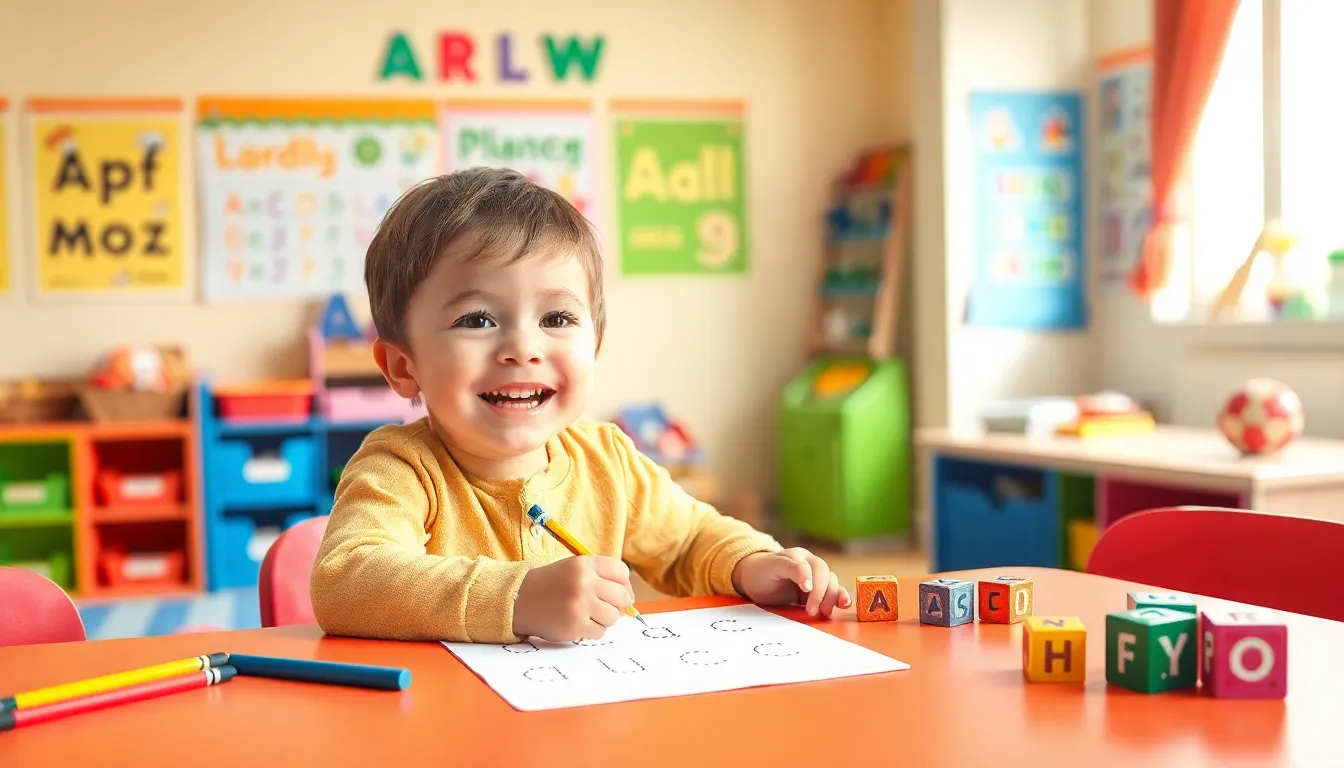Table of Contents
ToggleIn the whimsical world of preschool, where crayons reign supreme and imagination knows no bounds, writing worksheets are the secret sauce to sparking creativity. These magical sheets transform little scribbles into letters, and letters into words, all while keeping tiny hands busy and minds engaged. Who knew that learning could be this much fun?
Benefits Of Preschool Writing Worksheets
Preschool writing worksheets offer numerous advantages for young learners. These worksheets play a crucial role in developing essential skills that foster overall growth.
Enhancing Fine Motor Skills
Fine motor skills enhance through the use of preschool writing worksheets. Tracing letters and shapes encourages hand-eye coordination. Gripping crayons and pencils develops grip strength. As children engage in these activities, they refine their dexterity and control over writing tools. Engaging with different writing tasks motivates children to practice their movements. Gradual progression from basic strokes to letters increases confidence and proficiency. Children’s ability to hold a pencil properly improves, paving the way for future writing success.
Encouraging Cognitive Development
Cognitive development thrives with the use of preschool writing worksheets. Worksheets prompt children to recognize letters and understand their sounds. Associating letters with words encourages vocabulary expansion. Completing worksheets challenges young minds to follow directions and solve problems. Such activities stimulate critical thinking and reasoning skills. Children cultivate attention spans and memory retention through repetitive practice. Each completed worksheet reinforces learning concepts, providing a solid foundation for future literacy. Engaging regularly with these tasks supports neural connections essential for academic achievement.
Types Of Preschool Writing Worksheets

Preschool writing worksheets come in various formats, each designed to enhance different skills in young learners. These worksheets play a vital role in developing foundational writing abilities.
Tracing Worksheets
Tracing worksheets promote fine motor skill development by allowing children to practice letter formation. These worksheets often feature dotted lines for letters and shapes, guiding kids through each stroke. As children trace, they build confidence in their control and grip, essential for penmanship. Moreover, consistency in tracing activities aids recognition of shapes, improving visual-spatial awareness. Instructors and parents often use these worksheets to make learning engaging and interactive, encouraging children to enjoy the writing process as they progress.
Matching Activities
Matching activities focus on reinforcing letter recognition and sound association. These worksheets typically include pictures paired with letters, prompting children to match each object with its corresponding letter. This format engages kids through visual and auditory learning styles, promoting active participation. While matching, children enhance their vocabulary and cognitive skills, essential components in early literacy. Utilizing these activities also fosters critical thinking as children determine the correct connections, making learning both fun and fruitful.
How To Choose The Right Worksheets
Selecting the right preschool writing worksheets requires careful consideration of various factors. Prioritizing age appropriateness ensures that activities align with a child’s developmental stage.
Age Appropriateness
Choosing worksheets suited for a child’s age enhances engagement and effectiveness. Materials for younger preschoolers should feature simple tasks with large print and basic shapes. Advanced learners benefit from more complex activities that introduce uppercase and lowercase letters. Worksheets tailored to age groups provide appropriate levels of challenge. Furthermore, observing a child’s reaction to worksheet difficulty can guide future selections.
Educational Value
Assessing the educational value of writing worksheets plays an essential role in selection. High-quality worksheets should incorporate elements that promote fine motor skills and encourage letter recognition. Educational content must connect to broader literacy goals, like fostering vocabulary growth. Worksheets that include illustrations can enhance comprehension through visual cues. Finally, ensuring that tasks are interactive helps maintain a child’s interest while reinforcing learning outcomes.
Tips For Using Writing Worksheets Effectively
Creating an effective writing worksheet experience involves several key strategies that enhance engagement and learning.
Creating A Positive Environment
Establishing a supportive atmosphere boosts children’s confidence. Encourage children to express themselves freely, making them feel safe and valued. Positive reinforcement helps promote a growth mindset, so praise their efforts, regardless of the accuracy. Setting aside specific times for writing fosters a routine where children can focus on their tasks without distractions. Allowing room for creativity through open-ended prompts can stimulate their imagination and lead to more enjoyable experiences. Incorporating comfortable seating and proper lighting contributes to an optimal learning setting, ensuring children remain focused and comfortable during activities.
Incorporating Fun Elements
Integrating playful components into writing worksheets makes learning engaging. Using colorful designs captures children’s attention and maintains interest. Incorporate activities that involve storytelling or drawing to connect writing with imagination, allowing for self-expression. Reward systems, such as stickers or stamps, can motivate children to complete tasks enthusiastically. Creating themes around favorite characters or interests can make worksheets relatable and enjoyable. Encouraging collaborative activities with peers also promotes social interaction, enhancing the overall learning experience and making writing a fun and interactive endeavor.
Preschool writing worksheets play a vital role in nurturing young learners’ skills and creativity. By transforming basic scribbles into letters and words, these worksheets not only make learning enjoyable but also foster essential fine motor skills and cognitive development.
Choosing age-appropriate materials ensures that children engage with tasks suited to their developmental level, enhancing their confidence and motivation. Incorporating fun elements and collaborative activities further enriches the learning experience, making writing a delightful journey.
Ultimately, preschool writing worksheets lay a strong foundation for literacy and academic success, equipping children with the tools they need to thrive in their educational journey.





